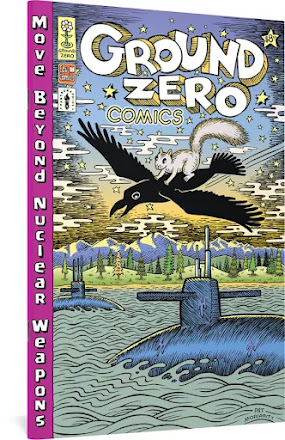Caitlin McGurk. Tell Me a Story Where The Bad Girl Wins: The Life and Art of Barbara Shermund. Seattle: Fantagraphics, 2024. ISBN-13: 9798875000041. $45. https://www.fantagraphics.com/products/tell-me-a-story-where-the-bad-girl-wins-the-life-and-art-of-barbara-shermund
Caitlin McGurk’s book about the late cartoonist Barbara Shermund makes plain its goal in the introduction: "we can’t claim that Barbara Shermund was the first to do anything, the last to do anything, or the best to do anything…But her work was good, and it was strong, and there was once a time when it was everywhere.” Throughout the book, the reader can see McGurk thinking aloud in the text, taking care to credit others while showing her work, but the introduction makes clear one of the impulses at the heart of a lot of comics studies: the work is interesting, and it compelled the author to learn more about the artist who made it.
Shermund worked in advertising and drew movie posters, but she was best known in her lifetime as a gag / panel magazine cartoonist and illustrator. One of the first three women inducted into the National Cartoonists Society, Shermund contributed to both The New Yorker and Esquire magazines for decades, in addition to her 1944-57 syndicated comic strip Shermund’s Sallies at King Features. The book is an oversized hardcover and McGurk and the book’s designers use the large size to present Shermund’s artwork in a variety of ways. From full page spreads, to pages showing four illustrations, to pages where the images are fitted in between the text, this might be considered the default option as far as presenting comic art in a book, but it seems an especially good choice considering that much of Shermund’s work originally appeared in magazines. Most of the images are presented in a larger size than they might have originally appeared, but it provides a sense of how people would have read them at the time, as well as how Shermund no doubt thought they would be seen.
What stands out most to me is how much McGurk was able to write about Shermund, given how little information there is about the cartoonist. An intensely private person, Shermund left little behind about the details of her life. This fact meant that McGurk had less to write about, but it also meant that she leaned into that gap and focused on Shermund’s artwork. Other times, like when detailing the generally shameful way that women were treated by the National Cartoonist Society, McGurk relies mostly on the writings and recollections of other people involved to give an accounting of what happened, the reader left to understand what being a professional female cartoonist meant at the time.
One reason that there is so few secondary sources about Shermund is that she was ignored or dismissed by decades of scholarship about these two prominent magazines, with her name misspelled and sometimes not even mentioned in surveys of the slick magazines’ cartoonists despite the hundreds of pieces she drew for Esquire with more than a thousand for The New Yorker. It is only in recent years that comics historians – primarily women – such as Liza Donnelly recognized and celebrated Shermund, and McGurk, who is the Curator of Comics and Cartoon Art at The Billy Ireland Cartoon Library and Museum, and Associate Professor at Ohio State University, is careful to credit them.
This generosity towards previous scholarship makes clear McGurk’s perspective on comics, as one would hopefully expect from a comics librarian at one of the biggest collections in the United States. Just as she sees Shermund as an artist in conversation with others, McGurk sees her own scholarship in conversation with a network of people with shared and overlapping interests and tastes. That includes the responsibility scholars have in acknowledging these debts, both in our own works and those we write about.
The book’s title paraphrases the caption in one of Shermund’s most famous cartoons, but it also feels like a challenge and a description of what McGurk wanted to do in this book. To remind the world there once was a woman who became an artist, and though she was never rich, spent decades doing what she loved and helped to define an iconic American magazine. She lived a life of her choosing and spent years in a house on the shore where she fished and swam in the ocean. And decades later, upon her return to public awareness, people still read and love her comics.
The book is a great look at an artist. It is a comprehensive look at Shermund’s life as a commercial cartoonist and illustrator that is also an art book with scholarly integrity. More than that, it gestures at a way forward in comics studies, noting that there are still many cartoonists who have been ignored, forgotten and erased and that whatever canon exists should remain in flux for a reason and there is much work left to do. McGurk’s rediscovery of Shermund’s work and her life conveys a feeling of freedom and excitement about what is possible in comics studies, and the book celebrates that feeling and why Shermund’s work can remain relevant and visceral.
Alex Dueben is a writer and historian who has written over 1,000 articles about comics and books, poetry and art for The Believer, Vulture, The Millions, The Los Angeles Review of Books, The Brooklyn Rail, and many other publications. Formerly a writer at Comic Book Resources, he has been a regular contributor to The Comics Journal and other leading comics publications for years, and is the writer and editor of the artist monograph Hurricane Nancy.











